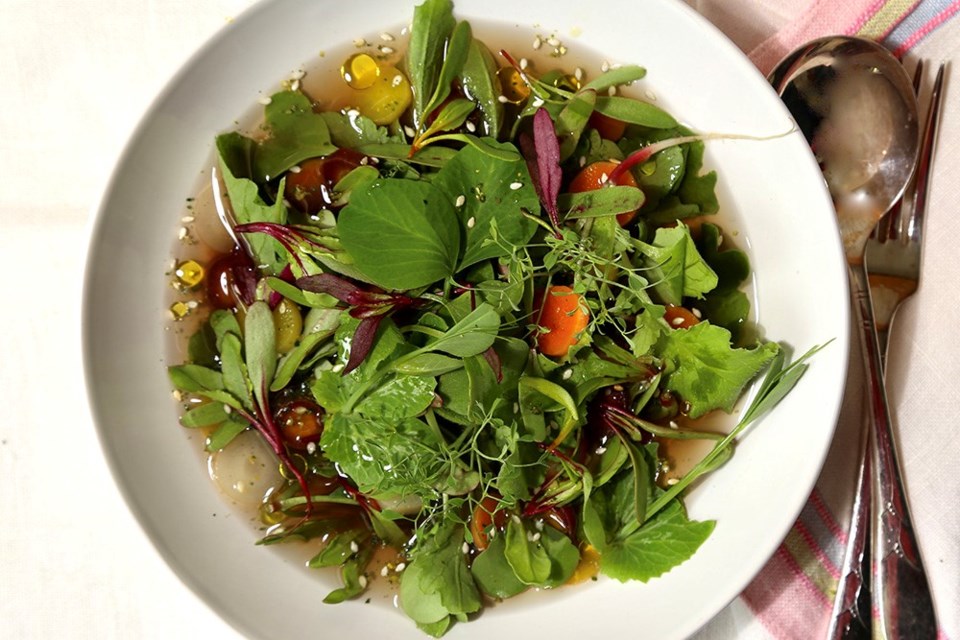There is no better way to enjoy the nutrient-dense terroir of your garden than to indulge in très élégant vitamin and mineral rich, thinning soup made from wilting the tiny wee carrot, radish, and beet plants that are typically tossed out during row thinning, into a steaming bowl of dashi or mushroom broth.
Growing fruits and vegetables at home, from seed, most particularly during challenging weather, has taught me to waste not, want not — that is to see, taste and revere the inherent and potential value in every edible component part.
Growing food regeneratively has taught me to share with and feed the soil. During root vegetable thinning time, feeding and sharing means gently cutting surplus seedlings at soil level, leaving the roots below ground, and the soil undisturbed.
This can take longer than thinning by pulling seedlings root and all, but then more time in the garden is time well spent.
Leaving soil undisturbed as much as possible, helps maintain the critical structure, aeration and porosity created by microbes, insects, worms, fungi, bacteria, and other microorganisms, and it allows biomass (roots, etc) to die and be consumed, and ultimately, after a many organism long process of eating and being eaten, store carbon and myriad goodness below ground for cycling.
That goodness is particularly well expressed in seedling plants like micro carrot, radish, beet and pea tops. You can taste the goodness of the soil, climate, culture and sunlight — the terroir — in every bite.
On that note, and in the "earth care, people care, fair share" spirit of urban permaculture, most of the thinnings end up in the in-bed worm composts, where red wrigglers and their rhizosphere (root neighbourhood) ecosystem of ravenous shredders, collectors, scrapers, piercers, predators and parasites feast throughout the seasons, creating the very best detritus and poopy native fertilizer to power yet another generation of nutrient dense produce for family and friends.
If you haven’t tasted root vegetable seedlings, you should give them a try. Unlike microgreens, which are most often grown in a sterile medium, on a fibre mat, or in a soil-less mixture where they absorb soluble nutrients from fortified irrigation, living soil grown seedlings pull a custom, terroir-specific blend of macro and micro nutrients directly from the soil, and also from its maker. That maker would be you, the urban gardener and soil steward. How cool is that?
This week, we nourished ourselves with a quick and delicious thinning soup, made by wilting just-snipped beet, carrot, radish and pea tops into a gorgeous and nourishing hot dashi broth brightened with sliced baby rainbow carrots.
To deepen the broth colour and its characteristic umami, I rehydrated some dried shiitake mushrooms. The silky earthiness of the fungi-enriched dashi, together with the peppery sweet and wilted thinnings were made more delicious still by a flourish of home-made kale-based gomasio.
Gomasio is a Japanese condiment made from toasted sesame seed, and kombu seaweed. A non-traditional kale-based version can be made easily by dehydrating kale pieces that have been massaged with salted garlic oil, then crushed into toasted sesame seeds. A pinch or two of crushed red pepper flakes elevates the kale gomasio even further.
Admittedly, it was very satisfying enjoying the highly nutritious and terroir-tasting thinning soup made almost exclusively from ingredients — radish (French breakfast, watermelon, red rido, Italian globe), beet (bull’s blood, touchstone gold, golden flame, chioggia), carrot (rainbow, bolero, chantenay, white satin), pea tops (parsley, sugar snap, alderman), kale (curly), garlic (red Russian) and peppers (fire ring, hot cherry, jalapeno) — grown in our front yard garden.
Thankfully root vegetables, peas, kale, garlic and peppers are not fussbudget veggies that require copious oversight and maintenance, or to be honest, any degree of gardening experience or expertise. How perfect for busy people.
New gardeners with limited space or containers even, could grow all of the above easily, in healthy soil powered by a little bit of sunshine. It isn’t too late to sow beets, carrots and radishes directly into the soil, and garden centres still have kale, pepper and spring garlic starts for transplanting.
Pairs beautifully with Gentil d’Alsace. Give it a try.
Laura Marie Neubert is a West Vancouver-based urban permaculture designer. Follow her on Instagram @upfrontandbeautiful, learn more about permaculture by visiting her Upfront & Beautiful website or email your questions to her here.
For a taste of permaculture, click on the YouTube link below:
(Video - Courtesy of West Vancouver Memorial Library)



